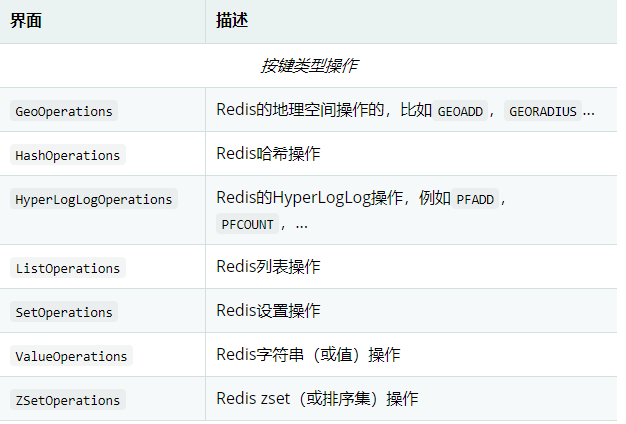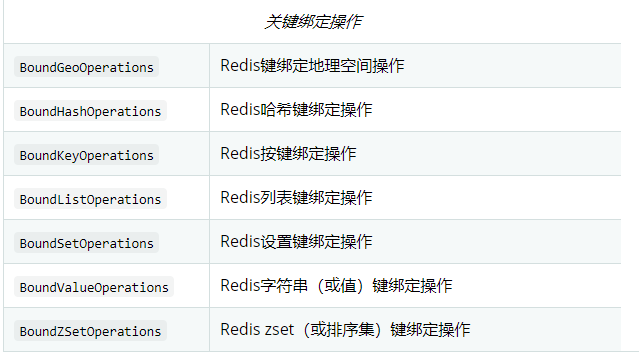StringRedisTemplate
由于存储在Redis中的键和值非常普遍java.lang.String,因此Redis模块提供了RedisConnection和的两个扩展RedisTemplate,分别是StringRedisConnection(及其DefaultStringRedisConnection实现),并且StringRedisTemplate是用于密集型String操作的便捷的一站式解决方案。除了绑定到String键之外,模板和连接还使用StringRedisSerializer下方,这意味着存储的键和值是人类可读的(假设Redis和您的代码使用相同的编码)。
StringRedisTemplate 继承了RedisTemplate类,只是所有的KV序列化都设置为 StringRedisSerializer.UTF_8。
public class StringRedisTemplate extends RedisTemplate<String, String> {
public StringRedisTemplate() {
this.setKeySerializer(RedisSerializer.string());
this.setValueSerializer(RedisSerializer.string());
this.setHashKeySerializer(RedisSerializer.string());
this.setHashValueSerializer(RedisSerializer.string());
}
public StringRedisTemplate(RedisConnectionFactory connectionFactory) {
this();
this.setConnectionFactory(connectionFactory);
this.afterPropertiesSet();
}
protected RedisConnection preProcessConnection(RedisConnection connection, boolean existingConnection) {
return new DefaultStringRedisConnection(connection);
}
}测试案例:
@Test
void stringRedisTemplateTest() {
stringRedisTemplate.boundValueOps("kkk").set("vvv");
String value = stringRedisTemplate.boundValueOps("kkk").get();
stringRedisTemplate.boundHashOps("hashkkk").putIfAbsent("kkk","vvv");
System.out.println(value);
}查看redis中的数据,发现都为String,很方便阅读:

RedisTemplate
Operations
RedisTemplate对Redis的每种数据类型都提供了响应的Operation对象,对数据进行操作。
Bound开头需要绑定Key,其对应的操作API都是一样的


@Test
void operationsTest(){
// Key-Value
BoundValueOperations<String, Object> boundValueOperations = redisTemplate.boundValueOps("key");
ValueOperations<String, Object> valueOperations = redisTemplate.opsForValue();
// List
BoundListOperations<String, Object> boundListOperations = redisTemplate.boundListOps("list:key");
ListOperations<String, Object> listOperations = redisTemplate.opsForList();
// Set
BoundSetOperations<String, Object> boundSetOperations = redisTemplate.boundSetOps("set:key");
SetOperations<String, Object> setOperations = redisTemplate.opsForSet();
// Zset
BoundZSetOperations<String, Object> boundZSetOps = redisTemplate.boundZSetOps("zset:key");
ZSetOperations<String, Object> zSetOperations = redisTemplate.opsForZSet();
// Hash
BoundHashOperations<String, Object, Object> boundHashOperations = redisTemplate.boundHashOps("hash:key");
HashOperations<String, Object, Object> hashOperations = redisTemplate.opsForHash();
// BitMaps (无)
// HyperLogLog
HyperLogLogOperations<String, Object> hyperLogLogOperations = redisTemplate.opsForHyperLogLog();
// Stream
BoundStreamOperations<String, Object, Object> boundStreamOperations = redisTemplate.boundStreamOps("stream:key");
StreamOperations<String, Object, Object> streamOperations = redisTemplate.opsForStream();
// Geo
BoundGeoOperations<String, Object> boundGeoOperations = redisTemplate.boundGeoOps("geo:key");
GeoOperations<String, Object> geoOperations = redisTemplate.opsForGeo();
}
BoundValueOperations
// Key-Value
BoundValueOperations<String, Object> boundValueOperations = redisTemplate.boundValueOps("key");
ValueOperations<String, Object> valueOperations = redisTemplate.opsForValue();
// 设定key对应的vlaue值
boundValueOperations.set("set");
// 将value值从第offset位开始替换
boundValueOperations.set("oop", 1);
// 设置value并设置过期时间1小时
boundValueOperations.set("ooo", Duration.ofHours(1));
// 设置value并设置过期时间3600秒
boundValueOperations.set("opo", 3600, TimeUnit.SECONDS);
// 返回key对应的value
Object value = boundValueOperations.get();
System.out.println("value:" + value);
// 从0开始,到1结束,截取value的值
String valueOfSub = boundValueOperations.get(0, 1);
System.out.println("valueOfSub:" + valueOfSub);
// 替换value的值,并且返回value的旧值
Object oldValue = boundValueOperations.getAndSet("new");
System.out.println("oldValue" + oldValue);
// 判断key是否有对应的value,如果有,则返回false,如果没有,添加,返回true
Boolean setIfAbsent = boundValueOperations.setIfAbsent("setIfAbsent");
System.out.println("setIfAbsent" + setIfAbsent);
// 判断当前的键的值是否为v,是的话不作操作,不实的话进行替换。如果没有这个键也不会做任何操作。
Boolean setIfPresent = boundValueOperations.setIfPresent("setIfPresent");
System.err.println("setIfPresent" + setIfPresent);
// 在value值后面进行添加,并且返回新value的长度
Integer append = boundValueOperations.append("append");
System.out.println("append" + append);
// 返回value的长度
Long size = boundValueOperations.size();
System.out.println("size" + size);
// 返回key的剩余缓存时间,单位:秒
Long expire = boundValueOperations.getExpire();
System.out.println("expire" + expire);
// 返回key的名称
String key = boundValueOperations.getKey();
System.out.println("key" + key);
// 返回数据的类型=》string、list。。。
DataType type = boundValueOperations.getType();
System.out.println("type" + type.name());
// 以下会报错,需要配置:redisTemplate.setValueSerializer(new GenericJackson2JsonRedisSerializer());
// INCR: value加1
boundValueOperations.set(1);
DataType boundValueOperationsType = boundValueOperations.getType();
System.out.println("type" + boundValueOperationsType.name());
Long increment = boundValueOperations.increment();
System.out.println("increment" + increment);
// INCR: value加100
Long increment1 = boundValueOperations.increment(100);
System.out.println("increment1" + increment1);
// DECR:value-1
Long decrement = boundValueOperations.decrement();
System.out.println("decrement" + decrement);
// DECR:value-1000
Long decrement1 = boundValueOperations.decrement(1000);
System.out.println("decrement1" + decrement1);
// INCR: value加3.14
Double increment2 = boundValueOperations.increment(3.14);
System.out.println("increment2" + increment2);
BoundListOperations
// List
BoundListOperations<String, Object> boundListOperations = redisTemplate.boundListOps("list:key");
ListOperations<String, Object> listOperations = redisTemplate.opsForList();
// 在List左边添加一个或多个值,返回List的长度
Long aaa = boundListOperations.leftPush("aaa");
System.out.println(aaa);
Long aLong1 = boundListOperations.leftPushAll("ddd", "eee", "fff");
System.out.println(aLong1);
// 从左边弹出值
Object leftPop = boundListOperations.leftPop();
System.out.println(leftPop);
Object leftPop1 = boundListOperations.leftPop(Duration.ofMinutes(5L));
System.out.println(leftPop1);
Object leftPop2 = boundListOperations.leftPop(1000, TimeUnit.SECONDS);
System.out.println(leftPop2);
// 返回List长度
Long size = boundListOperations.size();
System.out.println(size);
// 返回索引为2的值
Object index = boundListOperations.index(2);
System.out.println(index);
// 获取绑定键中给定的区间值,从下标0开始,end可以为-1表示最后一位
List<Object> range = boundListOperations.range(0, 2);
BoundSetOperations
// Set
BoundSetOperations<String, Object> boundSetOperations = redisTemplate.boundSetOps("set:key");
SetOperations<String, Object> setOperations = redisTemplate.opsForSet();
// 添加值,可以是集合、数组、多参数
Long aaa1 = boundSetOperations.add("aaa","bbb");
// 获取所有值
Set<Object> members = boundSetOperations.members();
// 返回第一个集合与其他集合之间的差异,也可以认为说第一个集合中独有的元素
Set<Object> diff = boundSetOperations.diff("set:diff");
// 找出两个集合的相同部分
Set<Object> intersect = boundSetOperations.intersect("set:diff");
// 找出兩個集合的并集
Set<Object> union = boundSetOperations.union("union");
// 返回1位置的值
Object index1 = boundListOperations.index(1);
// 移除某个元素
Long aaa2 = boundSetOperations.remove("aaa");
ZSetOperations
public interface ZSetOperations<K, V> {
@Nullable
Boolean add(K var1, V var2, double var3);
@Nullable
Long add(K var1, Set<ZSetOperations.TypedTuple<V>> var2);
@Nullable
Long remove(K var1, Object... var2);
@Nullable
Double incrementScore(K var1, V var2, double var3);
@Nullable
Long rank(K var1, Object var2);
@Nullable
Long reverseRank(K var1, Object var2);
@Nullable
Set<V> range(K var1, long var2, long var4);
@Nullable
Set<ZSetOperations.TypedTuple<V>> rangeWithScores(K var1, long var2, long var4);
@Nullable
Set<V> rangeByScore(K var1, double var2, double var4);
@Nullable
Set<ZSetOperations.TypedTuple<V>> rangeByScoreWithScores(K var1, double var2, double var4);
@Nullable
Set<V> rangeByScore(K var1, double var2, double var4, long var6, long var8);
@Nullable
Set<ZSetOperations.TypedTuple<V>> rangeByScoreWithScores(K var1, double var2, double var4, long var6, long var8);
@Nullable
Set<V> reverseRange(K var1, long var2, long var4);
@Nullable
Set<ZSetOperations.TypedTuple<V>> reverseRangeWithScores(K var1, long var2, long var4);
@Nullable
Set<V> reverseRangeByScore(K var1, double var2, double var4);
@Nullable
Set<ZSetOperations.TypedTuple<V>> reverseRangeByScoreWithScores(K var1, double var2, double var4);
@Nullable
Set<V> reverseRangeByScore(K var1, double var2, double var4, long var6, long var8);
@Nullable
Set<ZSetOperations.TypedTuple<V>> reverseRangeByScoreWithScores(K var1, double var2, double var4, long var6, long var8);
@Nullable
Long count(K var1, double var2, double var4);
@Nullable
Long lexCount(K var1, Range var2);
@Nullable
Long size(K var1);
@Nullable
Long zCard(K var1);
@Nullable
Double score(K var1, Object var2);
@Nullable
Long removeRange(K var1, long var2, long var4);
@Nullable
Long removeRangeByScore(K var1, double var2, double var4);
@Nullable
Long unionAndStore(K var1, K var2, K var3);
@Nullable
Long unionAndStore(K var1, Collection<K> var2, K var3);
@Nullable
default Long unionAndStore(K key, Collection<K> otherKeys, K destKey, Aggregate aggregate) {
return this.unionAndStore(key, otherKeys, destKey, aggregate, Weights.fromSetCount(1 + otherKeys.size()));
}
@Nullable
Long unionAndStore(K var1, Collection<K> var2, K var3, Aggregate var4, Weights var5);
@Nullable
Long intersectAndStore(K var1, K var2, K var3);
@Nullable
Long intersectAndStore(K var1, Collection<K> var2, K var3);
@Nullable
default Long intersectAndStore(K key, Collection<K> otherKeys, K destKey, Aggregate aggregate) {
return this.intersectAndStore(key, otherKeys, destKey, aggregate, Weights.fromSetCount(1 + otherKeys.size()));
}
@Nullable
Long intersectAndStore(K var1, Collection<K> var2, K var3, Aggregate var4, Weights var5);
Cursor<ZSetOperations.TypedTuple<V>> scan(K var1, ScanOptions var2);
@Nullable
default Set<V> rangeByLex(K key, Range range) {
return this.rangeByLex(key, range, Limit.unlimited());
}
@Nullable
Set<V> rangeByLex(K var1, Range var2, Limit var3);
@Nullable
default Set<V> reverseRangeByLex(K key, Range range) {
return this.reverseRangeByLex(key, range, Limit.unlimited());
}
@Nullable
Set<V> reverseRangeByLex(K var1, Range var2, Limit var3);
RedisOperations<K, V> getOperations();
public interface TypedTuple<V> extends Comparable<ZSetOperations.TypedTuple<V>> {
@Nullable
V getValue();
@Nullable
Double getScore();
}
}
BoundHashOperations
public interface BoundHashOperations<H, HK, HV> extends BoundKeyOperations<H> {
@Nullable
Long delete(Object... var1);
@Nullable
Boolean hasKey(Object var1);
@Nullable
HV get(Object var1);
@Nullable
List<HV> multiGet(Collection<HK> var1);
@Nullable
Long increment(HK var1, long var2);
@Nullable
Double increment(HK var1, double var2);
@Nullable
Set<HK> keys();
@Nullable
Long lengthOfValue(HK var1);
@Nullable
Long size();
void putAll(Map<? extends HK, ? extends HV> var1);
void put(HK var1, HV var2);
@Nullable
Boolean putIfAbsent(HK var1, HV var2);
@Nullable
List<HV> values();
@Nullable
Map<HK, HV> entries();
Cursor<Entry<HK, HV>> scan(ScanOptions var1);
RedisOperations<H, ?> getOperations();
}
HyperLogLogOperations
public interface HyperLogLogOperations<K, V> {
Long add(K var1, V... var2);
Long size(K... var1);
Long union(K var1, K... var2);
void delete(K var1);
}
BoundStreamOperations
public interface BoundStreamOperations<K, HK, HV> {
@Nullable
Long acknowledge(String var1, String... var2);
@Nullable
RecordId add(Map<HK, HV> var1);
@Nullable
Long delete(String... var1);
@Nullable
String createGroup(ReadOffset var1, String var2);
@Nullable
Boolean deleteConsumer(Consumer var1);
@Nullable
Boolean destroyGroup(String var1);
@Nullable
Long size();
@Nullable
default List<MapRecord<K, HK, HV>> range(Range<String> range) {
return this.range(range, Limit.unlimited());
}
@Nullable
List<MapRecord<K, HK, HV>> range(Range<String> var1, Limit var2);
@Nullable
default List<MapRecord<K, HK, HV>> read(ReadOffset readOffset) {
return this.read(StreamReadOptions.empty(), readOffset);
}
@Nullable
List<MapRecord<K, HK, HV>> read(StreamReadOptions var1, ReadOffset var2);
@Nullable
default List<MapRecord<K, HK, HV>> read(Consumer consumer, ReadOffset readOffset) {
return this.read(consumer, StreamReadOptions.empty(), readOffset);
}
@Nullable
List<MapRecord<K, HK, HV>> read(Consumer var1, StreamReadOptions var2, ReadOffset var3);
@Nullable
default List<MapRecord<K, HK, HV>> reverseRange(Range<String> range) {
return this.reverseRange(range, Limit.unlimited());
}
@Nullable
List<MapRecord<K, HK, HV>> reverseRange(Range<String> var1, Limit var2);
@Nullable
Long trim(long var1);
@Nullable
Long trim(long var1, boolean var3);
}
BoundGeoOperations
public interface BoundGeoOperations<K, M> extends BoundKeyOperations<K> {
@Nullable
Long add(Point var1, M var2);
/** @deprecated */
@Deprecated
@Nullable
default Long geoAdd(Point point, M member) {
return this.add(point, member);
}
@Nullable
Long add(GeoLocation<M> var1);
/** @deprecated */
@Deprecated
@Nullable
default Long geoAdd(GeoLocation<M> location) {
return this.add(location);
}
@Nullable
Long add(Map<M, Point> var1);
/** @deprecated */
@Deprecated
@Nullable
default Long geoAdd(Map<M, Point> memberCoordinateMap) {
return this.add(memberCoordinateMap);
}
@Nullable
Long add(Iterable<GeoLocation<M>> var1);
/** @deprecated */
@Deprecated
@Nullable
default Long geoAdd(Iterable<GeoLocation<M>> locations) {
return this.add(locations);
}
@Nullable
Distance distance(M var1, M var2);
/** @deprecated */
@Deprecated
@Nullable
default Distance geoDist(M member1, M member2) {
return this.distance(member1, member2);
}
@Nullable
Distance distance(M var1, M var2, Metric var3);
/** @deprecated */
@Deprecated
@Nullable
default Distance geoDist(M member1, M member2, Metric metric) {
return this.distance(member1, member2, metric);
}
@Nullable
List<String> hash(M... var1);
/** @deprecated */
@Deprecated
@Nullable
default List<String> geoHash(M... members) {
return this.hash(members);
}
@Nullable
List<Point> position(M... var1);
/** @deprecated */
@Deprecated
@Nullable
default List<Point> geoPos(M... members) {
return this.position(members);
}
@Nullable
GeoResults<GeoLocation<M>> radius(Circle var1);
/** @deprecated */
@Deprecated
@Nullable
default GeoResults<GeoLocation<M>> geoRadius(Circle within) {
return this.radius(within);
}
@Nullable
GeoResults<GeoLocation<M>> radius(Circle var1, GeoRadiusCommandArgs var2);
/** @deprecated */
@Deprecated
@Nullable
default GeoResults<GeoLocation<M>> geoRadius(Circle within, GeoRadiusCommandArgs args) {
return this.radius(within, args);
}
@Nullable
GeoResults<GeoLocation<M>> radius(K var1, M var2, double var3);
/** @deprecated */
@Deprecated
@Nullable
default GeoResults<GeoLocation<M>> geoRadiusByMember(K key, M member, double radius) {
return this.radius(key, member, radius);
}
@Nullable
GeoResults<GeoLocation<M>> radius(M var1, Distance var2);
/** @deprecated */
@Deprecated
@Nullable
default GeoResults<GeoLocation<M>> geoRadiusByMember(M member, Distance distance) {
return this.radius(member, distance);
}
@Nullable
GeoResults<GeoLocation<M>> radius(M var1, Distance var2, GeoRadiusCommandArgs var3);
/** @deprecated */
@Deprecated
@Nullable
default GeoResults<GeoLocation<M>> geoRadiusByMember(M member, Distance distance, GeoRadiusCommandArgs args) {
return this.radius(member, distance, args);
}
@Nullable
Long remove(M... var1);
/** @deprecated */
@Deprecated
@Nullable
default Long geoRemove(M... members) {
return this.remove(members);
}
}
总结
其实和Redis命令差不多,基本上提供了很多操作方法,实在太多了,后面的就懒得写的。。。可以对照Redis命令进行实践。一般实际项目中会自己封装RedisTemplate为工具了,配置一些常用的set\get\expire等操作就行。